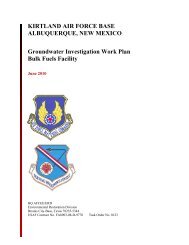Final FONSI and EA for hot cargo pad on Kirtland AFB - Kirtland Air ...
Final FONSI and EA for hot cargo pad on Kirtland AFB - Kirtland Air ...
Final FONSI and EA for hot cargo pad on Kirtland AFB - Kirtland Air ...
Create successful ePaper yourself
Turn your PDF publications into a flip-book with our unique Google optimized e-Paper software.
C<strong>on</strong>structi<strong>on</strong> Fugitive Dust Emissi<strong>on</strong> Factors<br />
General C<strong>on</strong>structi<strong>on</strong> Activities Emissi<strong>on</strong> Factor<br />
0.19 t<strong>on</strong> PM 10 /acre-m<strong>on</strong>th Source: MRI 1996; EPA 2001; EPA 2006<br />
The area-based emissi<strong>on</strong> factor <str<strong>on</strong>g>for</str<strong>on</strong>g> c<strong>on</strong>structi<strong>on</strong> activities is based <strong>on</strong> a study completed by the Midwest Research Institute (MRI) Improvement of Specific Emissi<strong>on</strong> Factors (BACM<br />
Project No. 1), March 29, 1996. The MRI study evaluated seven c<strong>on</strong>structi<strong>on</strong> projects in Nevada <str<strong>on</strong>g>and</str<strong>on</strong>g> Cali<str<strong>on</strong>g>for</str<strong>on</strong>g>nia (Las Vegas, Coachella Valley, South Coast <strong>Air</strong> Basin, <str<strong>on</strong>g>and</str<strong>on</strong>g> the San<br />
Joaquin Valley). The study determined an average emissi<strong>on</strong> factor of 0.11 t<strong>on</strong> PM 10 /acre-m<strong>on</strong>th <str<strong>on</strong>g>for</str<strong>on</strong>g> sites without large-scale cut/fill operati<strong>on</strong>s. A worst-case emissi<strong>on</strong> factor of 0.42<br />
t<strong>on</strong> PM 10 /acre-m<strong>on</strong>th was calculated <str<strong>on</strong>g>for</str<strong>on</strong>g> sites with active large-scale earth moving operati<strong>on</strong>s. The m<strong>on</strong>thly emissi<strong>on</strong> factors are based <strong>on</strong> 168 work-hours per m<strong>on</strong>th (MRI 1996). A<br />
subsequent MRI Report in 1999, Estimating Particulate Matter Emissi<strong>on</strong>s From C<strong>on</strong>structi<strong>on</strong> Operati<strong>on</strong>s, calculated the 0.19 t<strong>on</strong> PM 10 /acre-m<strong>on</strong>th emissi<strong>on</strong> factor by applying 25% of<br />
the large-scale earthmoving emissi<strong>on</strong> factor (0.42 t<strong>on</strong> PM 10 /acre-m<strong>on</strong>th) <str<strong>on</strong>g>and</str<strong>on</strong>g> 75% of the average emissi<strong>on</strong> factor (0.11 t<strong>on</strong> PM 10 /acre-m<strong>on</strong>th). The 0.19 t<strong>on</strong> PM 10 /acre-m<strong>on</strong>th<br />
emissi<strong>on</strong> factor is referenced by the EPA <str<strong>on</strong>g>for</str<strong>on</strong>g> n<strong>on</strong>-residential c<strong>on</strong>structi<strong>on</strong> activities in recent procedures documents <str<strong>on</strong>g>for</str<strong>on</strong>g> the Nati<strong>on</strong>al Emissi<strong>on</strong> Inventory (EPA 2001; EPA 2006). The<br />
0.19 t<strong>on</strong> PM 10 /acre-m<strong>on</strong>th emissi<strong>on</strong> factor represents a refinement of EPA's original AP-42 area-based total suspended particulate (TSP) emissi<strong>on</strong> factor in Secti<strong>on</strong> 13.2.3 Heavy<br />
C<strong>on</strong>structi<strong>on</strong> Operati<strong>on</strong>s. In additi<strong>on</strong> to the EPA, this methodology is also supported by the South Coast <strong>Air</strong> Quality Management District as well as the Western Regi<strong>on</strong>al <strong>Air</strong><br />
Partnership (WRAP) which is funded by the EPA <str<strong>on</strong>g>and</str<strong>on</strong>g> is administered jointly by the Western Governor's Associati<strong>on</strong> <str<strong>on</strong>g>and</str<strong>on</strong>g> the Nati<strong>on</strong>al Tribal Envir<strong>on</strong>mental Council. The emissi<strong>on</strong><br />
factor is assumed to encompass a variety of n<strong>on</strong>-residential c<strong>on</strong>structi<strong>on</strong> activities including building c<strong>on</strong>structi<strong>on</strong> (commercial, industrial, instituti<strong>on</strong>al, governmental), public works,<br />
<str<strong>on</strong>g>and</str<strong>on</strong>g> travel <strong>on</strong> unpaved roads. The EPA Nati<strong>on</strong>al Emissi<strong>on</strong> Inventory documentati<strong>on</strong> assumes that the emissi<strong>on</strong> factors are unc<strong>on</strong>trolled <str<strong>on</strong>g>and</str<strong>on</strong>g> recommends a c<strong>on</strong>trol efficiency of 50%<br />
<str<strong>on</strong>g>for</str<strong>on</strong>g> PM 10 <str<strong>on</strong>g>and</str<strong>on</strong>g> PM 2.5 in PM n<strong>on</strong>attainment areas.<br />
New Road C<strong>on</strong>structi<strong>on</strong> Emissi<strong>on</strong> Factor<br />
0.42 t<strong>on</strong> PM 10 /acre-m<strong>on</strong>th Source: MRI 1996; EPA 2001; EPA 2006<br />
The emissi<strong>on</strong> factor <str<strong>on</strong>g>for</str<strong>on</strong>g> new road c<strong>on</strong>structi<strong>on</strong> is based <strong>on</strong> the worst-case c<strong>on</strong>diti<strong>on</strong>s emissi<strong>on</strong> factor from the MRI 1996 study described above (0.42 t<strong>on</strong>s PM 10 /acre-m<strong>on</strong>th). It is<br />
assumed that road c<strong>on</strong>structi<strong>on</strong> involves extensive earthmoving <str<strong>on</strong>g>and</str<strong>on</strong>g> heavy c<strong>on</strong>structi<strong>on</strong> vehicle travel resulting in emissi<strong>on</strong>s that are higher than other general c<strong>on</strong>structi<strong>on</strong> projects.<br />
The 0.42 t<strong>on</strong> PM10/acre-m<strong>on</strong>th emissi<strong>on</strong> factor <str<strong>on</strong>g>for</str<strong>on</strong>g> road c<strong>on</strong>structi<strong>on</strong> is referenced in recent procedures documents <str<strong>on</strong>g>for</str<strong>on</strong>g> the EPA Nati<strong>on</strong>al Emissi<strong>on</strong> Inventory (EPA 2001; EPA 2006).<br />
PM 2.5 Multiplier 0.10<br />
PM 2.5 emissi<strong>on</strong>s are estimated by applying a particle size multiplier of 0.10 to PM 10 emissi<strong>on</strong>s. This methodology is c<strong>on</strong>sistent with the procedures documents <str<strong>on</strong>g>for</str<strong>on</strong>g> the Nati<strong>on</strong>al<br />
Emissi<strong>on</strong> Inventory (EPA 2006).<br />
C<strong>on</strong>trol Efficiency <str<strong>on</strong>g>for</str<strong>on</strong>g> PM 10 <str<strong>on</strong>g>and</str<strong>on</strong>g> PM 2.5 0.50<br />
The EPA Nati<strong>on</strong>al Emissi<strong>on</strong> Inventory documentati<strong>on</strong> recommends a c<strong>on</strong>trol efficiency of 50% <str<strong>on</strong>g>for</str<strong>on</strong>g> PM 10 <str<strong>on</strong>g>and</str<strong>on</strong>g> PM 2.5 in PM n<strong>on</strong>attainment areas (EPA 2006). Wetting c<strong>on</strong>trols will be<br />
applied during project c<strong>on</strong>structi<strong>on</strong>.<br />
References:<br />
EPA 2001. Procedures Document <str<strong>on</strong>g>for</str<strong>on</strong>g> Nati<strong>on</strong>al Emissi<strong>on</strong>s Inventory, Criteria <strong>Air</strong> Pollutants, 1985-1999. EPA-454/R-01-006. Office of <strong>Air</strong> Quality Planning <str<strong>on</strong>g>and</str<strong>on</strong>g> St<str<strong>on</strong>g>and</str<strong>on</strong>g>ards, United<br />
States Envir<strong>on</strong>mental Protecti<strong>on</strong> Agency. March 2001.<br />
EPA 2006. Documentati<strong>on</strong> <str<strong>on</strong>g>for</str<strong>on</strong>g> the <str<strong>on</strong>g>Final</str<strong>on</strong>g> 2002 N<strong>on</strong>point Sector (Feb 06 versi<strong>on</strong>) Nati<strong>on</strong>al Emissi<strong>on</strong> Inventory <str<strong>on</strong>g>for</str<strong>on</strong>g> Criteria <str<strong>on</strong>g>and</str<strong>on</strong>g> Hazardous <strong>Air</strong> Pollutants. Prepared <str<strong>on</strong>g>for</str<strong>on</strong>g>: Emissi<strong>on</strong>s<br />
Inventory <str<strong>on</strong>g>and</str<strong>on</strong>g> Analysis Group (C339-02) <strong>Air</strong> Quality Assessment Divisi<strong>on</strong> Office of <strong>Air</strong> Quality Planning <str<strong>on</strong>g>and</str<strong>on</strong>g> St<str<strong>on</strong>g>and</str<strong>on</strong>g>ards, United States Envir<strong>on</strong>mental Protecti<strong>on</strong> Agency. July 2006.<br />
MRI 1996. Improvement of Specific Emissi<strong>on</strong> Factors (BACM Project No. 1). Midwest Research Institute (MRI). Prepared <str<strong>on</strong>g>for</str<strong>on</strong>g> the Cali<str<strong>on</strong>g>for</str<strong>on</strong>g>nia South Coast <strong>Air</strong> Quality Management<br />
District, March 29, 1996.<br />
C-9 Project Fugitive
















